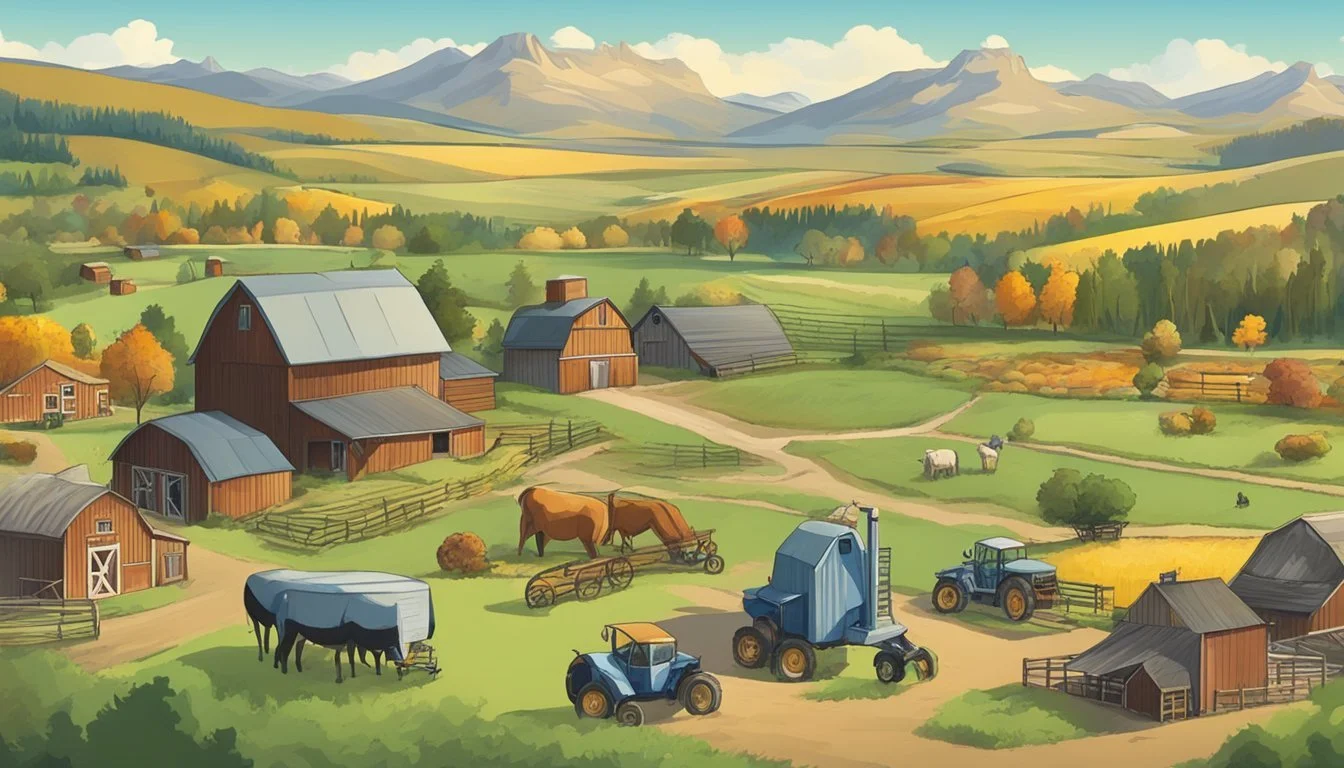Small Farms for Sale in Wyoming
Your Guide to Buying Rural Property
This Article is Part of State-by-State Guide to Buying Your First Small Farm
Wyoming's rural landscape offers a diverse array of small farms for sale, appealing to those interested in agriculture, a self-sufficient lifestyle, or simply living amidst the natural beauty of the state. With properties ranging in acreage, potential buyers have the opportunity to find farms that suit their needs, from modest ten-acre spreads to larger, still-manageable forty-acre tracts. These farms often come with the necessary infrastructure for agricultural pursuits, such as barns, irrigation systems, and existing dwellings for residential use. The real estate market for small farms in this region reflects a trend towards sustainable living and agriculture, augmented by Wyoming's favorable tax structure and commitment to landowner rights.
The market for small farms in Wyoming caters to a wide audience, from established farmers looking to downsize to new entrants eager to embark on their first foray into farming or ranching. The variety of properties available includes ranchlands suitable for livestock and pastures poised for crop cultivation, each offering a slice of the serene and rugged charm Wyoming is known for. Real estate listings indicate a range in both price and features, with some offering expansive homes and outbuildings, while others present a blank canvas for customization, all set against the state's expansive skies and scenic vistas. As such, the pursuit of finding the right small farm in Wyoming is as much about locating a piece of land as it is about embracing a particular way of life.
Understanding the Wyoming Market
The Wyoming real estate market for small farms shows distinct trends and characteristics unique to the state. It is defined by a range of property sizes and varying prices that reflect the diversity of the rural landscape.
Market Trends
Wyoming's market for small farms is characterized by a steady interest due to the state's favorable tax environment and significant rural appeal. Recent listings show demand for properties across Platte, Laramie, and Fremont counties. These areas offer differing landscapes, from the plains to mountain foothills, which appeal to a variety of buyers.
Price Analysis
A detailed examination reveals a spectrum of listing prices:
Platte County lists a 40-acre property at $899,999
Laramie County has a 24-acre farm priced at $1,275,000
Fremont County features a 10-acre property for $1,095,000
These listings demonstrate that prices can vary significantly based on location, acreage, and amenities, with price per acre fluctuating accordingly.
Property Size Considerations
Size is a key aspect when it comes to purchasing a farm in Wyoming. The properties range from smaller 5-acre farms to more extensive 40-acre plots. The land for sale is diverse, offering buyers a range of options:
Small farms (5-10 acres): Ideal for hobby farms or personal retreats.
Medium-sized plots (10-40 acres): Suitable for serious agricultural pursuits or larger scale operations.
The decision on property size will heavily influence the purchase price and the potential use of the land, making it a critical factor in the buying process.
Types of Small Farms
Wyoming offers a variety of small farms tailored to different lifestyles and agricultural interests. These properties can range from a few acres to over 40 acres, offering potential owners a chance to engage in small-scale farming, personal retreats, or a blend of both.
Hobby Farms
Hobby farms in Wyoming are typically characterized by their smaller acreage and are often purchased by those looking to enjoy rural life without a commitment to full-time farming. They can range in size but usually span across a few to several acres. These farms provide ample space for personal gardening, raising livestock for family use, and potentially generating supplemental income.
Size: 5-40 acres
Primary Use: Recreation, part-time agriculture
Example: A 6-bedroom seclusion in Wheatland, offering 40 acres of land and a spacious home.
Rural Mini Farms
Rural mini farms are a step up from hobby farms in terms of both size and agricultural potential. Found throughout Wyoming's scenic counties, they serve as a bridge for those interested in modest farming or self-sufficiency. With acreage generally between 10 and 50 acres, these farms support a variety of agricultural activities while still being manageable for individuals or small families.
Size: 10-50 acres
Primary Use: Small-scale commercial agriculture, self-sufficiency
Example: A 10-acre plot in Fremont County featuring a 4-bedroom home, suitable for a family looking to grow their own food and sell excess produce.
Country Farmettes
Country farmettes are the quintessence of rural living, offering larger homes, more land, and the peace of the countryside. These compact farms can offer between 4 and 30 acres of land, providing a balanced lifestyle for those who desire to farm on a small scale yet cherish their space and privacy.
Size: 4-30 acres
Primary Use: Residential, small-scale farming
Example: A charming 4-acre plot in Fremont County with a spacious 4-bedroom house, perfect for tranquil country living with a hands-on approach to farming.
Animal Husbandry on Small Farms
Animal husbandry contributes significantly to the agricultural profile of Wyoming's small farms, where livestock such as sheep, goats, and poultry are raised. These animals are integral to farm operations, either for their meat, milk, wool, or eggs. Proper management practices are crucial for the health of the animals and the economic viability of these small-scale farms.
Sheep Rearing
Wyoming's climate and terrain are conducive to sheep rearing, with small farms often favoring breeds suitable for both meat and wool. Farmers typically engage in:
Selective breeding: to enhance traits like wool quality and growth rates.
Health management: involving regular vaccinations and parasite control.
Sheep are also used for grazing management, helping control invasive plant species and maintain the health of the pastures.
Goat Farming
Goat farming is popular on Wyoming's smaller homesteads, with farmers raising goats for their milk, meat, and fiber. Goat farms implement:
Containment systems such as fenced pastures to protect goats from predators.
Nutritional planning: ensuring a diet that supports health and productivity.
Poultry Keeping
Poultry keeping is a versatile endeavor on these farms. Farmers may raise different species of poultry, such as chickens, ducks, or turkeys, for a variety of products. Key aspects include:
Housing: Keeping poultry in coops that offer protection and nesting space.
Feed: A balanced diet is essential for the poultry's growth and egg production.
Wyoming's small farms often sell poultry products locally, creating a fresh and sustainable option for consumers.
Location and Accessibility
When considering the purchase of small farms in Wyoming, location and accessibility are crucial factors for potential buyers. They must evaluate not only the geographical region, such as southern Wyoming but also how well-connected these properties are in terms of transport links and local amenities.
Southern Wyoming
Southern Wyoming offers a range of small farms, varying in acreage. Notable for its wide-open spaces and rural landscapes, this region includes farms with sizes such as a 24-acre property in Laramie County and a 5-acre property, also in Laramie County. Buyers looking for larger plots can find 40-acre farms in Platte County. These areas are known for their tranquility and closer proximity to the Colorado border, which may be a consideration for those seeking easy access to another state.
Transport Links
Smaller farms in Wyoming are often within reasonable distance to key transport routes. Main highways such as Interstate 80 (I-80) run across southern Wyoming, providing essential connectivity for farm owners to nearby cities and towns. Buyers must consider access to roads that can accommodate transportation needs for both personal and commercial purposes, ensuring that the farm is both reachable and capable of handling deliveries or shipments.
Local Amenities
Local amenities play a significant role in the day-to-day operations of a farm. Potential buyers should investigate proximity to necessities such as:
Grocery stores
Veterinary services
Agricultural suppliers
The towns of Cheyenne and Laramie are examples of areas where these amenities can be found. Having these resources readily available can contribute to the success and convenience of running a small farm in Wyoming.
Purchasing Process
In Wyoming, the process of purchasing a small farm involves understanding the legalities, exploring financing options, and efficiently closing the deal. Buyers should be prepared for a multifaceted journey as they navigate the particulars of real estate transactions, especially in rural settings.
Legal Aspects of Buying
The buyer must thoroughly understand the legal implications when purchasing real estate to ensure the transaction aligns with Wyoming's property laws. They should conduct a title search to confirm clear ownership history and check for any easements or liens that may affect the property. Due diligence is critical here, as it helps in identifying any legal obstacles that might complicate the transaction or affect the purchase price. For property size specifics, zoning laws and land use restrictions must be verified to ensure compliance with intended farm use.
Financing Options
Various financing options exist for buyers in Wyoming looking to purchase a small farm. Traditional mortgages are common, but one should not overlook agricultural loans specifically tailored for farm purchases. These loans can offer more favorable terms given the nature of the investment:
Farm Credit Services
FSA (Farm Service Agency) Loans
Conventional Bank Loans
Buyers need to evaluate their financial standing to secure a loan that aligns with their budget and the property size they aim to acquire.
Closing the Deal
Closing the deal on a farm sale involves several key steps:
Signing a Purchase Agreement: After agreeing on the purchase price, a legally binding contract is signed by both parties.
Escrow: A neutral third party holds the funds in an escrow account during the transaction.
Inspection and Appraisal: A farm inspection and appraisal is conducted to solidify the purchase price and ensure the real estate's value and condition.
Final Walk-Through: This step verifies the property's condition hasn't changed since the sale agreement.
Closing Day: The buyer completes all paperwork, finalizes the financing, and takes ownership of the farm.
By adhering to these steps and securing the necessary financing, buyers can purchase a small farm in Wyoming with confidence. Each step is essential to ensuring a legally sound and financially viable transaction.
Post-Purchase Considerations
Once the purchaser completes the acquisition of a small farm in Wyoming, there are critical steps to settle with respect to establishing habitation and launching commercial activities.
Building a Residence
When building a residence on a newly acquired farm, the owner must consider zoning laws, building permits, and the availability of utilities such as water, electricity, and waste management. They may opt for a variety of housing options, from constructing customized homes to setting up prefabricated structures. The selection largely depends on their budget, time constraints, and personal preferences.
Zoning Laws: Ensure the intended use complies with local regulations.
Building Permits: Obtain necessary approvals before construction.
Utilities: Plan for essential services—water, power, and waste.
Starting Commercial Operations
Initiating commercial operations on a small farm requires a clear business plan and understanding of the market dynamics. The owner should analyze local demand for different agricultural products and consider the necessary infrastructure to support such ventures, which could range from crop cultivation to livestock breeding.
Market Research: Identify which products have a high demand in the area.
Infrastructure: Assess and invest in essential structures like barns, storage, and processing facilities.
Regulations: Comply with health, safety, and agricultural standards.






